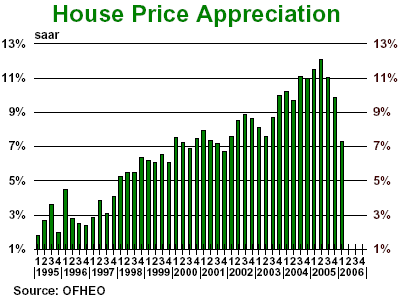
The text of two speeches, one given by the current
Federal Reserve Chief
Ben Bernanke in October 2002, the other given by Federal Reserve Governor
Donald L. Kohn in March 2006, may shed some light on the potential actions the Federal Reserve may take with respect to perceived asset bubbles as they expand and collapse.
Interestingly, although these speeches generally refer to the abstract notion of asset bubbles or to a historical record including the most recent hi-tech stock market bubble, the text seems to be weighing (or debating) the options for the Fed to take with respect to a particularly widely felt asset price correction.
Without a doubt, this debate was specifically coordinated around the current housing bubble, shrouded in notion of the Feds role with respect to asset bubbles in general. Certainly these speeches were “generally” on the topic of the Feds potential response to asset bubbles but I can hardly imagine that this debate was prompted by recent run-ups in the prices of copper or gold or as a post mortem on the hi-tech stock market crash.
In his 2002 speech, Bernanke identifies two groups who believe that the Federal Reserve should take a more active role in controlling asset bubbles. These groups only differ in the extent to which they think the Fed should react in the face of a highly probable asset bubble.
The “Lean against the Bubble” group would prefer that the Fed raise rates an additional 50 to 100 basis points above the level that might satisfy the Feds obligations to regulating the growth of the economy. This group perceives this additional rate increase as insurance against the possible greater effects that an even higher asset price collapse would have on the economy. So, in theory, since rate hikes are a blunt tool, the whole economy may be overly slowed with the additional rate increase, but if the hikes were to take the edge off of the particular asset bubble, the cost may be worth it since the severity of the bubble collapse may be mitigated.
The “Prick the Bubble” group would take an even more activist point of view, asserting that the Fed should raise rates even higher in order to force a collapse of the asset bubble. This group seems to see the severity of a widely felt asset bubble and the possibility of severe financial crisis as grounds for commensurate action.
Bernanke seems to take exception with both of these groups thereby seemingly carving out a third group with a “non activist” point of view for which he is a member.
Bernanke says the following of the “lean against the bubble” group:
“My sense is that this more moderate camp comprises the great majority of serious researchers who have advocated a monetary-policy response to bubbles. And, in my opinion, the theoretical arguments that have been made for the lean-against-the-bubble strategy are not entirely without merit.”
Of the “prick the bubble group”, Bernanke states the following:
“To be frank, this recommendation concerns me greatly, and I hope to persuade you that it is antithetical to time-tested principles and sound practices of central banking.”
Additionally, both Bernanke and Kohn question both, the ability for the Federal Reserve accurately perceive asset bubbles or price assets more accurately than the market, and “moral hazard” that may be posed by a Fed that chooses to price assets.
Bernanke says the following:
“First, the Fed cannot reliably identify bubbles in asset prices. Second, even if it could identify bubbles, monetary policy is far too blunt a tool for effective use against them.”
“Thus, to declare that a bubble exists, the Fed must not only be able to accurately estimate the unobservable fundamentals underlying equity valuations, it must have confidence that it can do so better than the financial professionals whose collective information is reflected in asset-market prices”
Bernanke goes on to suggest that monetary policy is too blunt a tool to effectively target individual assets classes, and would only achieve the desired results after having causing significant damage to the overall economy.
“In short, we cannot practice "safe popping," at least not with the blunt tool of monetary policy. The situation is further complicated if, as is usually the case, the suspected bubble affects only a specific class of assets, such as high-tech stocks. Certainly there is no way to direct the effects of monetary policy at a single class of assets while leaving other financial markets and the broader economy untouched. One might as well try to perform brain surgery with a sledgehammer.”
“Monetary policy is not a useful tool for achieving this objective, however. Even putting aside the great difficulty of identifying bubbles in asset prices, monetary policy cannot be directed finely enough to guide asset prices without risking severe collateral damage to the economy.”
Arguably the most important disclosure in this speech is that Bernanke seems to take the position that the appropriate action is to first, use the Feds supervisory powers and public awareness to help prevent the bubble for forming. If an asset bubble does form though, Bernanke does not see the Feds role as either actively causing the asset bubble to collapse or to bail out the its participants but rather to help quickly “mop up” the damage afterwards by using the Feds regulatory and “lender of last resort” powers to ensure the stability of the financial system.
Bernanke states:
“A far better approach, I believe, is to use micro-level policies to reduce the incidence of bubbles and to protect the financial system against their effects. I have already mentioned a variety of possible measures, including supervisory action to ensure capital adequacy in the banking system, stress-testing of portfolios, increased transparency in accounting and disclosure practices, improved financial literacy, greater care in the process of financial liberalization, and a willingness to play the role of lender of last resort when needed.”
Key to this point is that the individual investor should not expect individual attention or insurance from the Federal Reserve. Bernanke sees the role of the Federal Reserve as being focused on the health of the financial system as a whole and not on its individual participants.
To this effect Burnanke states:
“Because risk-taking is essential for economic dynamism, we do not want an economy in which investors and businesspeople are not free to take bets that might turn out badly.”
More recently, Federal Reserve Federal Reserve Governor Donald L. Kohn gave a speech in which he supported many of the arguments found in Bernankes speech including the Feds inability to accurately price assets and thus perceive asset bubbles, as well as the dangers implicit in the Fed attempting to set asset prices in order to eliminate speculative bubbles and how, ultimately, a timely response to an asset bubble collapse may well be the best way to prevent a Japan-style financial crisis.
The key disclosure in the Kohn speech is that he specifically refers to the current housing market and more importantly, to what the housing markets individual participants may expect from the Fed if a collapse were to occur.
Kohn states:
“Conventional policy as practiced by the Federal Reserve has not insulated investors from downside risk. Whatever might have once been thought about the existence of a "Greenspan put," stock market investors could not have endured the experience of the last five years in the United States and concluded that they were hedged on the downside by asymmetric monetary policy.”
“The same considerations [as was given to dot-com stock holders] apply to homeowners: All else being equal, interest rates are higher now than they would be were real estate valuations less lofty; and if real estate prices begin to erode, homeowners should not expect to see all the gains of recent years preserved by monetary policy actions. Our actions will continue to be keyed to macroeconomic stability, not the stability of asset prices themselves.”
Given the text of these speeches, it seems that any expectation or even enthusiasm about a Federal Reserve that is actively guiding the real estate market in for a “soft landing” should be greatly revised.
In fact, it may be that a “soft landing” could prove to do worse damage to real estate over time as an “orderly” cool down may lessen the spillover into other areas of the economy, thus preventing the Fed from taking action.












